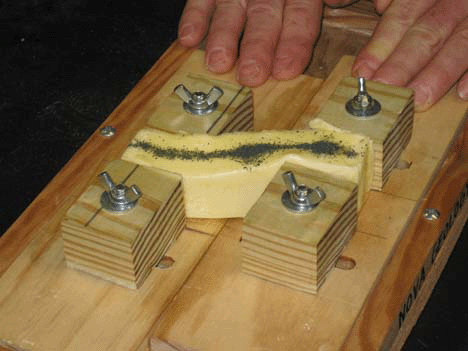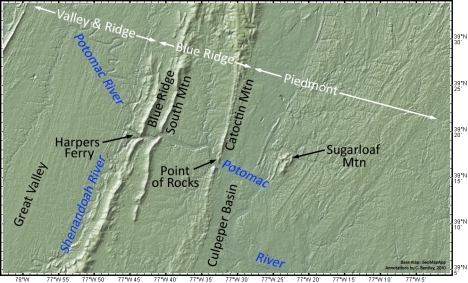Whilst discussing how to quantify strain with my GMU structural geology students recently, I hit upon a cool analogy. In order for you to understand the analogy (assuming you’re not a structural geologist), I’ll have to review some background information first. Stick with it, and I promise you a salamander at the end.
Structural geologists are interested in how rocks deform. If we have some idea of the original shape of a rock element (say, an oncolite, or a cooling column, or a fossil, or more prosaically, a sedimentary layer), and we find a deformed version of it, then we can use that object as a strain marker. By measuring its features, we can determine how parts of the strain marker have elongated, shortened, or rotated.
Elongation is pretty easy to calculate. You compare the final dimensions to the original dimensions via the equation e = (lf-lo)/lo where “lo” is the original length and “lf” is the final length.
If the strain marker has been elongated, then the value of e will be positive. If it has been shortened, then the value of e will be negative. Another value, S (for ‘stretch’) is also a useful parameter to calculate. S = lf/lo, which is the same as saying: S = e + 1
As a quick example, a line which has been deformed from an original length of 20 cm to a final length of 30 cm has an elongation of 0.5. It has a stretch of 1.5. Put another way, the line has been increased in length by 50% (of its original length), and it is now 150% as long as it originally was.
Here’s a little diagram to summarize:
Okay — so far, so good. We can now calculate length changes. But many of the structural elements in a strain marker not only change their length, but also their orientation. That is to say, they rotate. In order to quantify that, we need to thinking about shear strain. Shear strain (γ), is calculated from angular shear (ψ), a quantity that is measurable in a rock element (again, provided you have a clear idea of what it looked like before deformation).
For any given line in a strain marker, angular shear is defined as the deviation (in degrees) from perpendicular for a line which was originally perpendicular to the line we care about. That is a ridiculous definition at first glance, and it seems to many students quite non-intuitive why one would bother looking for a line originally perpendicular to the line on which we are actually trying to measure the angular shear! I mean, is that abstractified or what?
Before I reveal my stunning new analogy for angular shear, let me diagram the definition for you, and relate it to shear strain.

The line we care about (blue) looks quite the same after deformation as it looked before deformation. So we can’t actually measure anything about it directly that has changed. But when we look at a line which we know was originally perpendicular to it (gray/red), we can measure how it has changed.
The angle between the old perpendicular-line and the new ‘perpendicular’- line is ψ, the angular shear. By convention, clockwise rotations of the perpendicular-line are given positive values, while counter-clockwise rotations are assigned negative values. In the above example, the rotation is clockwise by 35°, so we note it as “ψ = +35°”.
Another way to think about this situation is to consider any point on our perpendicular-line. Here, let’s consider point A:

A was originally at the end of the old perpendicular-line (gray), in position Ao. After deformation, it is now at the end of the new ‘perpendicular-line’ (red), in position Af. You can see that this outlines a right triangle (yellow):

Right triangles are lots of fun, because they allow us to practice trigonometry. You may remember the mnemonic phrase “SOHCAHTOA” from your high-school trigonometry class. Basically, this relates the angle ψ to the lengths of the sides of the right triangle, where S refers to sin(ψ), C refers to cos(ψ), and T refers to tan(ψ). (That’s sine, cosine, and tangent, respectively.) “O” is the length of the side opposite the corner of the triangle with the ψ angle. “A” is the length of the non-hypotenuse side adjacent to the ψ-angled corner. “H” is the length of the hypotenuse itself. So the change in the position of point A, which could be expressed as Δ(A), is equal to the length of the ‘opposite’ side relative to the length of the ‘adjacent’ side of the triangle. The length of the adjacent side isn’t changing through this deformation, but the length of the opposite side is changing. With a little deformation, it changes a little. With a lot of deformation, the length of that O side increases dramatically.
The formula for calculating shear strain from angular shear is: γ = tan(ψ)
So, with a large value of ψ, you get a large value for tan(ψ). The shear strain (γ) increases along the line we care about (blue) with increasing rotation of the ‘perpendicular’-line (red). The maximum value of ψ would be approaching 90°, which means that your γ would be close to infinity. The minimum angular shear, 0°, would yield a shear strain of 0. Here’s a table of other possible values.
Okay, got it? …(Whew!)
Now for the salamander!
In order to express to my structure students why we bother to pay attention to that ‘perpendicular’-line, I wanted to get them into the perspective of the line we care about: I wanted to get them into its mindset. But of course, lines are geometric entities, and don’t have minds. They are hard to identify with. So I opted for a salamander, because they are cute. Furthermore, salamanders are roughly linear organisms, and have legs poking out of them at roughly right-angles to their spinal column. Here’s my blackboard sketch:

So if you think about what the salamander experiences as it gets sheared (right-lateral), you can imagine what shear strain feels like. The legs go from an original orientation (purple chalk) to a deformed orientation (blue chalk), rotating by about 45°. Along the length of the salamander’s body (orange chalk), the angular shear is 45°, and the tangent of 45° is 1. So the shear strain along the length of this poor salamander is 1. What this means is that the tips of the salamander’s toes (the equivalent of point A in the earlier diagrams) have moved one whole leg-length to the right of their original positions. You can put some numbers to this if you want: Say the leg length is 1.5 cm, and the toes are displaced 1.5 cm. Remember SOHCAHTOA… γ = tan(ψ) = opp/adj = 1.5/1.5 = 1.
There’s something else on the diagram, too: a yellow line. This makes the point that if the leg-line of the salamander is the “line you care about,” and not the spine-line, then the spine-line can be “the line originally perpendicular to the line you care about.” If you’re measuring the angular shear along the leg lines, you would want to measure how the spine-line has rotated relative to its original position. As a result of the shearing deformation in this example, the spine-line has rotated by 45° counter-clockwise. So we’d say: “ψ = -45°”. The tangent of -45° is -1. The shear strain on the leg-line is therefore exactly the opposite of the shear strain on the spine-line.
But the key point of this analogy is to put your mind in the salamander’s perspective, and “feel” the shear strain along the length of your body as deformation proceeds. I hope that intuiting shear strain from that perspective will be useful to structure students learning these concepts.
Filed under: amphibians, analogies, art, math, structure | 3 Comments »





























